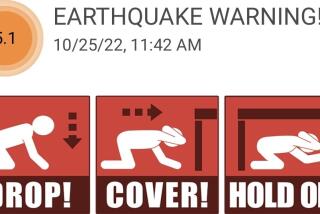Experts Oppose Cutbacks in Quake Stations
A group of experts has expressed concern at the Bush administration’s proposal to cut in half the appropriations for a national network of 6,000 earthquake monitoring stations, including 1,000 new stations in Southern California.
In an attempt to convince Congress of the value of the program and get the installation schedule back on track, the U.S. Geological Survey has set up a briefing for members of Congress and their staffs in Washington on Thursday. The briefing will be presented by two California seismic officials and a private expert on the New Madrid fault zone in the Midwest.
Congress authorized $170 million three years ago for installation and maintenance of the earthquake monitoring stations. But so far it has appropriated only about $9 million for the effort.
Now, the Bush administration is proposing to cut the appropriation back in the next fiscal year to $2 million from $4 million, enough only to maintain the stations that already exist. Originally, the project was supposed to be completed in five years -- a deadline that officials now say will not be met.
Bruce Clark, the chairman of the California Seismic Safety Commission, said Thursday he will tell the members of Congress that “it’s shameful and incredibly shortsighted” to let the work languish and that lawmakers “should ramp up their appropriation to at least $10 million a year by fiscal 2004.”
The Bush administration does not state in its budget why it proposed the cutback.
The stations will allow the timely development of shake maps that will show emergency officials within minutes where damage from a severe quake has occurred and allow them to rush aid to where it’s most needed, Clark said.
“This is a new era,” he observed, “We can have information we’ve never had before, and it’s absolutely critical.”
Clark will be accompanied at the hourlong Capitol Hill briefing by Lucy Jones, scientist in charge of the U.S. Geological Survey’s Southern California office in Pasadena, and Richard Howe of the ABS Consulting firm in Memphis, Tenn., close to the site of devastating 1811-12 quakes centered in the Midwest.
Jones, as a federal official, is not authorized to lobby the Congress, but she will describe at the briefing how the monitoring system will operate. Howe will describe how it applies to building safety.
Jones said Thursday that, under the recently developed TriNet system, Southern California has installed 700 monitoring stations. Still, she said, there are gaps between stations that leave the shake maps somewhat vague in the areas relatively far from the stations.
For instance, she said, instrumentation was able to show fairly precisely where damage from the 1994 Northridge earthquake occurred in Santa Monica, but not in Pacific Palisades, where there were no stations at the time.
More to Read
Sign up for Essential California
The most important California stories and recommendations in your inbox every morning.
You may occasionally receive promotional content from the Los Angeles Times.










